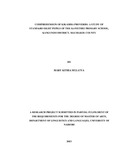| dc.description.abstract | The study is an investigation of the comprehension of Kikamba proverbs, by
standard eight pupils of the Kawethei primary school, Kangundo District,
Machakos County.
The linguistic data in this study will be analysed using the cognitive semantics
approach as described in Evans and Green (2006). Cognitive semantics approach
to linguistic research was pioneered by Eve Tweetser (1990) and Leonard Talmy
(2000). It was developed to counter truth-conditional semantics. Cognitive
semantics approach is concerned with research on conceptual content and its
organization in language.
The study has been divided into five chapters. Chapter one captures general
background information of the study. This includes background to the language,
statement of the problem, objectives, hypotheses, rationale, scope, theoretical
framework, literature review, research methodology and the significance of the
study.
Chapter two covers the in depth study of proverbs and their general classification.
The chapter covers the description of the selected Kikamba proverbs and their
classification into broad categories: those that relate to animals, human beings,
people and activities, and those that relate to other phenomena.
Chapter four contains the analysis of the findings in terms of correct/incorrect
responses and the percentages of correct/incorrect responses. The discussion of the
findings is based on the guiding principles of the cognitive semantics approach to
semantic study.
Chapter five gives a summary of the research findings and conclusions by relating
the findings to the research objectives and the hypotheses. Recommendations are
also presented in this chapter.
Data was drawn from Mutisya, R. (2002) Kikamba Proverbs and Idioms.
Information on the meanings of the selected Kikamba proverbs was collected by
use of a questionnaire that was administered to twenty standard eight pupils of the
Kawethei Primary School. The target of respondents was thirty (the entire class)
but on the day of data collection only twenty pupils were available | en |

